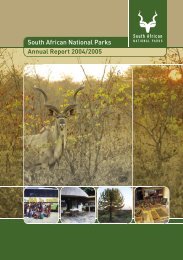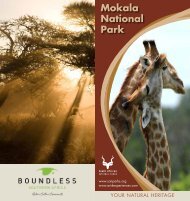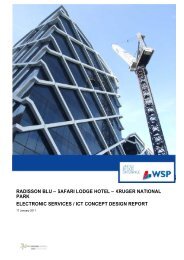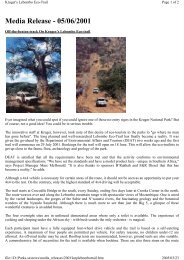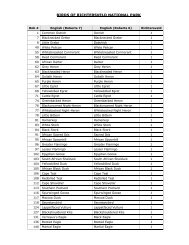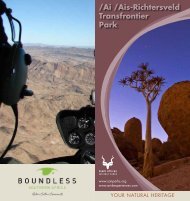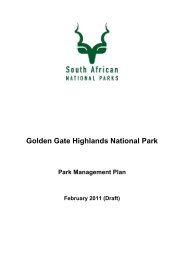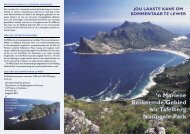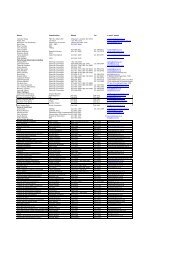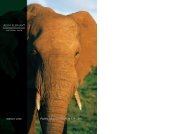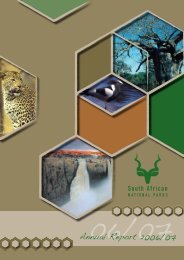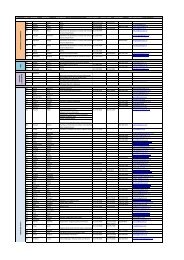Silvermine Tented Campsite Silvermine Tented Campsite - SANParks
Silvermine Tented Campsite Silvermine Tented Campsite - SANParks
Silvermine Tented Campsite Silvermine Tented Campsite - SANParks
- No tags were found...
You also want an ePaper? Increase the reach of your titles
YUMPU automatically turns print PDFs into web optimized ePapers that Google loves.
efore after EPWP Teams dressing rock found onsite<br />
- used for building of the Boma<br />
& Lapa fire pit<br />
"Found" wany post in front deck<br />
of four sleeper<br />
60% of all EPWP Teams are woman Red-river gum being stock-piled at<br />
Orange Kloof post felling, for milling<br />
The Shower units under<br />
construction<br />
The four sleeper tent<br />
under construction<br />
The finished passive solar water<br />
heating panels<br />
The first guide to test the water flow<br />
of the showers WHB's<br />
One of the battery units used<br />
to power lights<br />
A guide relaxes by the dover stove<br />
inside the Boma<br />
The Septic tank - re-commissioning<br />
the existing site<br />
Existing boardwalk and bridge prior<br />
to construction<br />
The Boma under construction<br />
5 months ago<br />
The "Kearboom seed-pod" lights<br />
being installed by artist Andy Lord<br />
1. THE REHABILITATED<br />
Wetland and Wet Season<br />
Water Course. An<br />
artificial water course<br />
leading to a man-made<br />
dam 50 m below the<br />
entrance bridge has been<br />
rehabilitated and will reestablish<br />
itself in front of<br />
the viewing deck this<br />
winter for the first time<br />
in 14 years.<br />
The first conceptual layout<br />
of the fire lapa area<br />
2. RECYCLING of rock<br />
that was left on site after<br />
previous forest station<br />
was demolished<br />
3. USING FOUND &<br />
RECYCLED MATERIALS<br />
The stone, some alien<br />
trees found on the site<br />
and the alien trees cleared<br />
from Table Mountain<br />
National Park have been<br />
incorporated and re-used<br />
in the buildings and other<br />
facilities.<br />
4. JOB CREATION while<br />
building the tented camp<br />
More than 30 EPWP<br />
team members where<br />
directly responsible for<br />
building the tented camp<br />
- the Boma walls, the<br />
boardwalks, rockwork and<br />
much more. 90% of all<br />
project wages were paid<br />
to EPWP Teams, and 90%<br />
of campsite built by<br />
EPWP Teams<br />
6. LAPA - FIREPLACE AND THE NORTH, EAST, SOUTH AND WEST POINTERS.<br />
The Lapa was designed around the face of a compass with the pointers giving direction.<br />
The rocks were all found on site. The deck timber is Red River Gum cleared above<br />
Kirstenbosch Gardens and sawn and treated at the Orange Kloof - where the hikers will<br />
spend the next night.<br />
a guide to the<br />
design and<br />
construction<br />
5. DESIGN & BUILDING<br />
METHODS OF THE<br />
BOMA. The timber is all<br />
alien trees felled in TMNP<br />
- Pine, Poplar, Red River<br />
Gum, Oak, White Cyprus.<br />
Much of it was saw-milled<br />
and cured at Orange Kloof<br />
(the next overnight camp<br />
on the Hoerikwago Trail)<br />
The stone was recycled<br />
on the site, Likewise all<br />
sandbags where filled<br />
onsite Good insulation is<br />
provided by Eco-beam<br />
system. Much of this work<br />
was done by the poverty<br />
relief teams. Many of the<br />
feature elements such as<br />
counters, basins, furniture<br />
have been crafted from<br />
the same alien timber by<br />
"Forest Creations"<br />
<strong>Silvermine</strong><br />
<strong>Tented</strong><br />
<strong>Campsite</strong><br />
8. DESIGN AND<br />
BUILDING METHODS<br />
OF THE TOILETS AND<br />
SHOWERS - These are<br />
designed to be "open" in<br />
the environment. The<br />
curved walls borrow from<br />
the spiral shapes found in<br />
shells and other natural<br />
forms, and provide<br />
sympathetic, un-square<br />
spaces. They remain<br />
comfortable in badweather<br />
conditions. Their<br />
services are discussed<br />
below.<br />
The Sanex toilets from the back<br />
7. DESIGN AND<br />
BUILDING METHODS<br />
OF SLEEPING TENTS -<br />
Secure, comfortable<br />
canvass tents (designed<br />
in-house) inside weather<br />
proof structure (shelter)<br />
with alien timber to floor,<br />
structure, and latte. They<br />
must withstand gale-force<br />
winds on the mountain<br />
and are hung reasonably<br />
low and designed to<br />
deflect the wind from the<br />
canvas.They are well<br />
ventilated, comfortable,<br />
providing indoor and<br />
outdoor facilities, and they<br />
sit "lightly" in the<br />
landscape.<br />
9. SOLAR HEATED<br />
WATER .The solar water<br />
heater panels or plates<br />
ensure that hot water<br />
should be provided most<br />
days of the year. They use<br />
an indirect, closed loop<br />
system of heating, and they<br />
have a backup - a manual<br />
switch-over to<br />
instantaneous gas heaters<br />
- which it is expected<br />
might need to be switched<br />
on if there have been<br />
about 4 days of thick<br />
cloud.The switch-over<br />
valve is set at 60 Degrees<br />
C. If the temperature of<br />
the water exceeds this the<br />
valve , user will add cold<br />
water.<br />
10. WATER SUPPLY to the<br />
tented camp. Two 5500<br />
liter holding tanks are fed<br />
from the <strong>Silvermine</strong> Dam.<br />
The water is supplied to<br />
the camp via a contained<br />
loop which makes the<br />
most the low pressure.<br />
The potable water is<br />
filtered via filters below the<br />
two sinks in the Boma<br />
(kitchen area).<br />
11. TOILETS The Enviro-loo (Sanex) dry composting toilets uses a conveyor belt to move<br />
the solids to a compartment where they are naturally dried. The liquids are drained<br />
separately. Please see the interpretation board that explains the toilet in more detail.<br />
12 ELECTRICITY<br />
SUPPLY - FOR<br />
LIGHTING. Due to<br />
numerous thefts of photovoltaic<br />
panels (PVP's) in<br />
the area, we have opted<br />
for a car-battery system -<br />
the batteries are charged<br />
off-site. We expect them<br />
to be able to provide<br />
electricity for about a<br />
week if used sparingly. In<br />
the medium term we<br />
expect to 'top-up' these<br />
batteries using small wind<br />
turbines on site - and thus<br />
we won't need the offsite<br />
charging. In other<br />
camps we have tried to<br />
use Photo-voltaic solar<br />
collectors but these have<br />
often been vandalized.<br />
There are no additional<br />
transport costs associated<br />
to off-site charging as the<br />
campsite is serviced each<br />
day by vehicle anyway.<br />
15. FIRE PREVENTION<br />
Making fires on the<br />
mountain can be<br />
dangerous, especially in<br />
summer, windy conditions<br />
- the dry season. The<br />
guides will inform the<br />
hikers whether it is safe to<br />
make fires on the days of<br />
the hikes. Fire extinguishers<br />
are provided at all<br />
structures, and we have<br />
planted a 3 m fygies<br />
"bubble" (a natural fire<br />
retardant) around most<br />
structures. The fire stove<br />
in the Boma is fitted with<br />
3 spark-arrestors to<br />
prevent sparks escaping<br />
through the chimney. We<br />
also have a formal fire callout<br />
procedure for the<br />
tented camp<br />
13. WASTE WATER<br />
DRAINAGE The waste<br />
water from the basins,<br />
showers and sink are<br />
drained via a septic tank<br />
(included in this is an<br />
aerator pump reducing<br />
the volume of sulfates<br />
generated) to a soak-away<br />
in a selected part of the<br />
site where it drains<br />
through filtering layers into<br />
the ground. Please limit<br />
any toxic substances<br />
deposited into the drains.<br />
14. RAINWATER<br />
drainage The previously<br />
disturbed wetland on the<br />
site is being rehabilitated.<br />
This will take a few years<br />
but should contribute<br />
to a very wonderful<br />
environment immediately<br />
in front of the Boma,<br />
viewing decks and<br />
Sleeping Tents. We intend<br />
to install a few rainwater<br />
tanks to harvest rainwater<br />
from the roofs of the<br />
buildings to collect<br />
emergency water supplies.<br />
17. BOMA KITCHEN<br />
The Boma is fitted with<br />
simple catering facilities<br />
and equipment. Please<br />
use carefully. The lights and<br />
water should be used<br />
wisely (avoid waste). The<br />
fire-stove can be used to<br />
heat the space, and to<br />
cook some great meals.<br />
The guide will help hikers<br />
to make the best use of<br />
it.The outside fireplace<br />
"braai" should only be used<br />
under the explicit guidance<br />
of the hike guides (never<br />
on days when there is a<br />
fire risk) There are gas<br />
cooking facilities inside the<br />
Boma.<br />
18. TIMBER FURNITURE The inside and outside counters and work surfaces, beds, tables,<br />
chairs, benches, cupboards, beds, backpack stands, windows and doors are all crafted by<br />
Forest Creations from alien timber cleared from Table Mountain by the Hoerikwaggo Trails<br />
Project Team. The outside counter in front of the Boma is crafted from a piece of White<br />
Cypress found on the site, milled at Orange Kloof and finished on site here.<br />
16. INDOOR AND<br />
OUTDOOR LIGHTS<br />
These use energy-efficient<br />
light bulbs, but should be<br />
turned off when not<br />
needed. Their design uses<br />
the forms of Keurboom<br />
seed pods, and open,<br />
cracked seed pods. The<br />
brass light fittings resemble<br />
Arum Lillies.<br />
The beds and side tables hand made<br />
from red river gum
THE DESIGN THEME for this campsite is<br />
"The Mountain Fynbos experience"<br />
All construction and design approaches follow the<br />
Touching the Earth Lightly maxim which states:<br />
"Touch the earth lightly" is a maxim that expresses the<br />
relationship between people and the earth - an<br />
association based on custodianship, sensitivity and<br />
respect, that results in developments that have the<br />
least impact (visually, physically, ecologically) on the<br />
natural landscape.<br />
The appreciation of a "sense of place" of the site is<br />
evoked by its natural location, character and intrinsic<br />
qualities have informed our project. We trust that<br />
you will enjoy it while you are here, and take the<br />
memory of its delight with you when you leave<br />
No bricks, no cement or concrete was used in<br />
construction of this camp (only weak mix concrete<br />
foundations contained inside a thick DPC membrane<br />
to prevent any leaching) All construction technology<br />
is labor-intensive and suitable to the skills of our job<br />
creation / poverty relief construction teams. With<br />
the exception of 25 commercially sourced and treated<br />
turned poles, we have used only alien vegetation, all<br />
sourced ourselves from within TMNP. This has resulted<br />
in additional job creation and fynbos restoration. We<br />
have used least toxic materials, treatments or finishes<br />
as possible, and designed water-wise and energyefficient<br />
facilities wherever possible.<br />
The structures are simply constructed, strong enough<br />
to shelter users from the winds, rain, heat and cold,<br />
but which would leave little disturbance to the site<br />
if we wanted to remove the camp. In fact all that<br />
would be left are the holes in which we placed our<br />
poles. The site is an old forest station and we will<br />
slowly be rehabilitating it - restoring the natural<br />
features and indigenous flora.<br />
It has been designed and built for you in an effort to<br />
provide an affordable and memorable escape in our<br />
City-wilderness - this while setting new standards in<br />
"softening the footprint of tourism" on our priceless<br />
mountain.<br />
The single wash hand basin is<br />
made from Pine<br />
19. WASH BASINS The<br />
wash basins are designed<br />
to resemble mountain<br />
rock pools. The basin at<br />
the toilet is made from<br />
one piece of pine (Pinus<br />
Pinaster). The double<br />
basin in the shower is<br />
made from one solid<br />
piece of White Cypress<br />
sourced from demolished<br />
<strong>Silvermine</strong> Homestead<br />
Hoerikwaggo Trails guides using<br />
the climbing wall for the first time<br />
20. THE CLIMBING WALL This is aimed<br />
at providing additional public recreation<br />
facilities within the TMNP for all. The<br />
objective of the climbing wall is to provide<br />
a facility for people of different levels of<br />
experience an interactive, fun, educational<br />
outdoor activity by climbing a graded,<br />
interpreted, accessible & unpretentious<br />
climbing wall. The aim is to raise<br />
awareness for the sport of climbing in<br />
general by offering a basic "taster" to inexperienced<br />
climbers and highlighting<br />
the fact that there is great crag climbing<br />
only 300m from the tented camp<br />
overnight facility itself.<br />
View from inside, raining outside<br />
21. THE SKY-LIGHT IN<br />
THE BOMA - bringing<br />
the "outside" "in" The<br />
skylight aims to decrease<br />
usage of alternative<br />
energy powered light by<br />
maximizing use of natural<br />
light above the food prep<br />
surface. It also bring the<br />
beautiful view of the<br />
Yellow-woods "into" the<br />
Boma Furthermore it<br />
provide a sense of<br />
"shelter" for the user from<br />
the very visible wind/rain<br />
weather elements.<br />
22. JOB CREATION The construction technology, materials, details and the<br />
method of building provided opportunity to employ unskilled people from<br />
local settlements. They have been able to contribute substantially to the building<br />
work and have taken good interest in their work and the final product We<br />
hope to further support these exiting teams through the establishment of a<br />
basic SMME that sells branded hiking sticks made from the off-cuts of alien<br />
vegetation generated from the construction of the Hoerikwaggo Trails <strong>Tented</strong><br />
Camps (black wattle). Please have a closer look at the hiking stick given to<br />
you today. We aim to sell these hiking sticks to tourists at the Lower Cable<br />
way station.<br />
The first branded walking stick made by the exiting EPWP Teams of TMNP.<br />
To book a Hoerikwaggo Hiking Trail call Patricia on tel (021)465 8515/9<br />
Notes for reader: These images and notes introduce the basic approach ideas, features, materials and some design details used in the<br />
design and construction of this tented campsite. If you are interested or have any questions, please feel free to ask one of the Hoerikwaggo<br />
Trails staff. For more information on the planning, design, construction and future construction the remaining tented camps please contact<br />
the Hoerikwaggo Trails Project Manager Stephen Lamb on (021) 701 8692 (TMNP Offices) or e-mail Stephenl@sanparks.org



